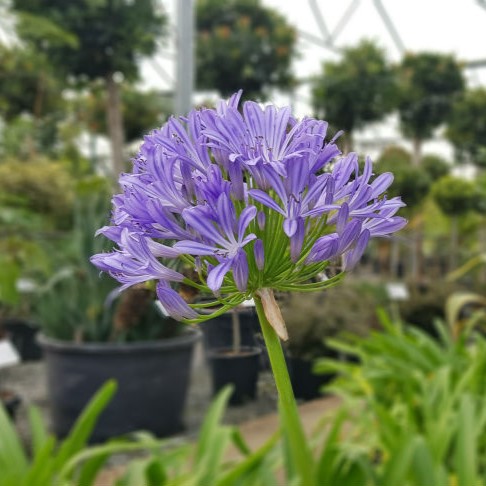Expanding Agapanthus: A Complete Guide to Beautiful Blooms
Understanding the Art of Agapanthus Treatment: Essential Steps for Healthy And Balanced Development and Vibrant Blooms
In the realm of cultivation, the growing of agapanthus stands as a rewarding endeavor for those who look for to support these sophisticated flowering plants. With their striking flowers and graceful vegetation, agapanthus has actually recorded the focus of gardeners worldwide. Nevertheless, achieving optimum growth and vibrant blooms requires a nuanced technique that includes various vital steps. From choosing the right selection to mastering trimming strategies, the trip in the direction of cultivating prospering agapanthus plants is complex and holds the crucial to opening the full possibility of these herb gems.

Choosing the Right Agapanthus Variety

When selecting the best Agapanthus range for your yard, think about elements such as climate viability, blossom color, and growth practice. Agapanthus, typically referred to as Lily of the Nile or African lily, can be found in a selection of shades ranging from tones of blue and purple to white. Select a flower shade that matches your existing yard combination to develop an unified landscape. In addition, consider the climate in your region to guarantee the Agapanthus range you choose can flourish in your certain problems. Some selections are more tolerant of cold temperature levels, while others prefer warmer environments. Comprehending the development routine of various Agapanthus varieties is essential for correct placement within your yard. Some varieties have a clumping growth practice, perfect for containers or boundaries, while others have an even more dispersing nature, appropriate for ground cover or mass growings. By carefully reviewing these aspects, you can choose the excellent Agapanthus variety to boost the appeal of your garden.
Suitable Growing Conditions
Considering the optimum ecological needs is necessary for successful Agapanthus farming. Agapanthus grows in well-draining soil with a slightly acidic to neutral pH degree. When planting, select a location that gets complete sunlight to partial color. In hotter environments, providing some mid-day color can prevent scorching of the fallen leaves. Agapanthus plants are delicate to chilly temperature levels and need to be secured from frost throughout winter season.
To make certain healthy development and vibrant blossoms, plant Agapanthus light bulbs at a depth of concerning 2-4 inches and space them 8-12 inches apart. Mulching around the base of the plants assists keep wetness and suppresses weed growth.
Watering and Feeding Tips
Maintaining appropriate wetness degrees and offering important nutrients are crucial aspects in the care routine for Agapanthus plants. When it comes to watering Agapanthus, it is crucial to strike a balance. These plants prefer constantly wet soil yet are susceptible to root rot if overwatered.
Fertilizing Agapanthus is necessary for promoting healthy and balanced growth and prolific blossoms. Use a well balanced fertilizer, such as a 10-10-10 formula, in the early spring as new growth emerges. Repeat this application every 6-8 weeks throughout the growing season. Prevent too much fertilizing, as it can result in lavish foliage at the expenditure of flowers. Always follow the producer's instructions for appropriate dilution and application techniques. By complying with these watering and fertilizing suggestions, you can guarantee your Agapanthus plants grow and produce vibrant, lasting blooms.
Trimming Methods for Agapanthus
Trimming Agapanthus plants at the proper times and with appropriate techniques is essential for keeping their health and wellness and promoting ideal growth and blooming. The optimal time to prune Agapanthus is in read review late wintertime or early spring before new development emerges.
Deadheading invested flowers can likewise reroute the plant's energy right into generating more blooms instead than establishing seeds. If you want to gather seeds for proliferation, leave some blossoms to dry and fully grown on the plant.
Remember to make use of clean, sharp tools to make specific cuts and decrease the threat of presenting illness. Agapanthus. Normal pruning will certainly aid keep your Agapanthus looking neat and healthy and balanced while guaranteeing a plentiful display screen of gorgeous blossoms
Dealing With Common Bugs and Illness
After making certain proper pruning methods for Agapanthus, it is important to address common insects and diseases that can influence the health and wellness and vigor of these plants. Agapanthus plants are usually hardy but can still fall target to certain problems. One typical insect that impacts Agapanthus is the this website Agapanthus gall midge. This tiny, orange fly lays its eggs in the foliage, leading to distorted growth and flower buds that stop working to open. To fight this insect, trim and damage any type of affected plant components and consider utilizing insecticidal soap.
Additionally, Agapanthus plants can endure from root rot if they are planted in poorly draining pipes dirt. By being watchful and taking punctual action against pests and conditions, you can aid your Agapanthus plants flourish and generate lively flowers. Agapanthus.

Conclusion
In verdict, mastering the art of agapanthus care involves selecting the right range, offering suitable growing conditions, appropriate watering and feeding, proper trimming techniques, and addressing usual insects and conditions. By complying with these essential steps, you can guarantee healthy and balanced growth and vibrant flowers for your agapanthus plants. Keep in mind to regularly monitor and keep your plants to promote their total health and longevity.
To guarantee the original source healthy development and vivid blooms, plant Agapanthus light bulbs at a deepness of concerning 2-4 inches and space them 8-12 inches apart. By complying with these watering and feeding pointers, you can ensure your Agapanthus plants flourish and produce lively, long-lasting flowers.
One usual bug that affects Agapanthus is the Agapanthus gall midge. In addition, Agapanthus plants can suffer from root rot if they are planted in poorly draining pipes dirt. By following these necessary steps, you can make certain healthy growth and vibrant flowers for your agapanthus plants.